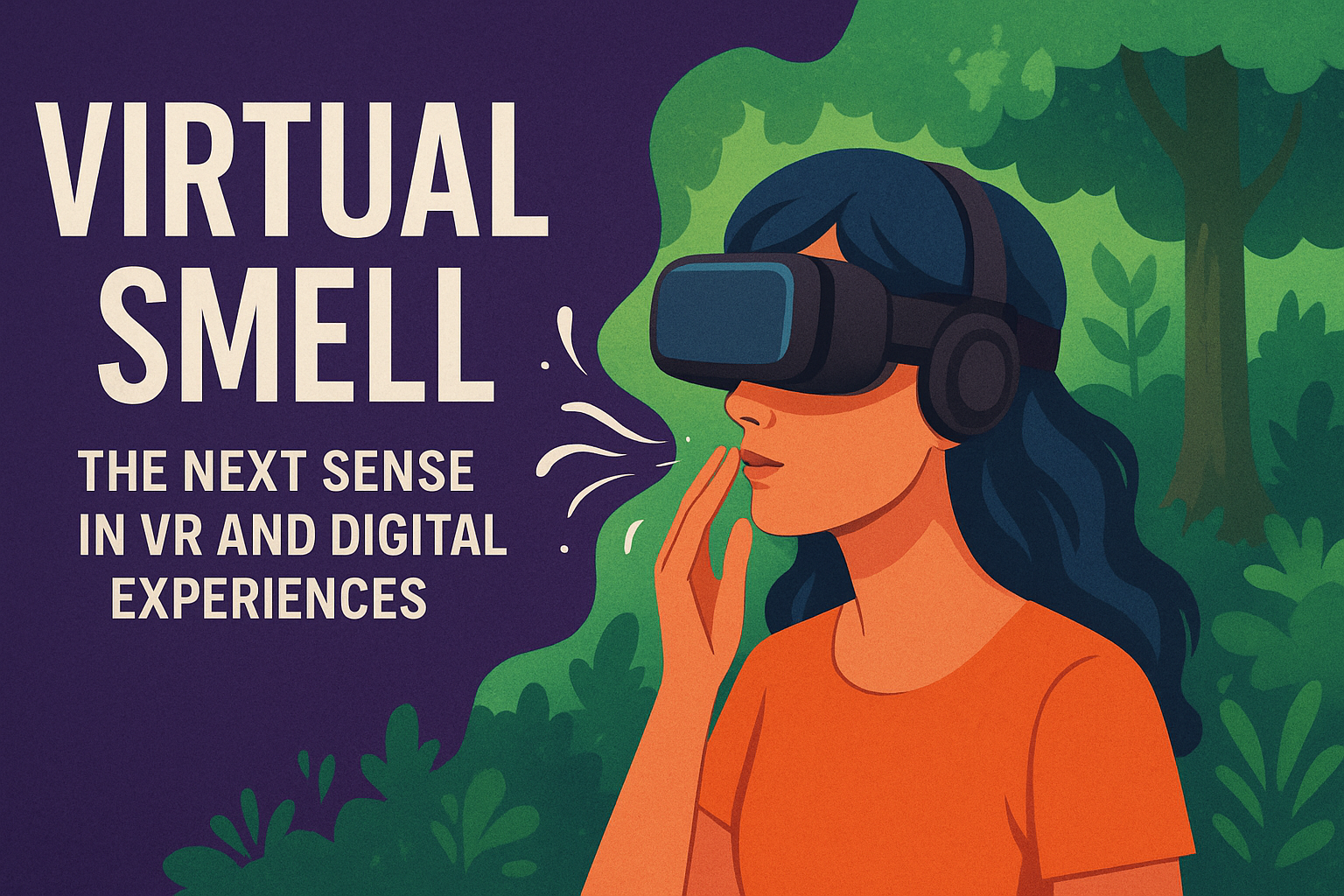Virtual Smell — The Next Sense in VR and Digital Experiences
Introduction
For years, VR has dazzled us with sights and sounds — but something has always been missing: the power of smell. Imagine walking through a digital forest and actually sensing pine trees, or feeling nostalgia triggered by a familiar fragrance in a virtual memory space. Virtual smell is no longer science fiction; it’s quietly becoming the next big leap in immersive tech. Here’s how scent is reshaping the way we experience digital worlds.

Transitioning from Sight to Smell: The Shift to Immersivity
The concept of virtual reality for the longest time has been about presence — the sense of being present, “inside”, another world. We have seen tremendous leaps in the technologies of visuals, sound, and even touch. However, smell has been almost totally ignored. Nevertheless, scent is one of our most powerful senses and is a dominant sensory trigger for emotion and memory. A scent can transport you back years and can change your entire mood by simply smelling something that triggers memory. Now innovators are realizing that a true immersive experience cannot be complete without the involvement of the nose. Collaborations between gaming studios, wellness start-ups, and creators are testing the limits with ‘scent diffusers’, coordinating scents to virtual environments, such as ocean air on a virtual beach or the scent of campfire when in a VR forest. As this seemingly natural evolution of sensory experience continues, scent may truly be the final element that engages a fully alive digital experience.
The Science of Virtual Smell
Creating a digital-smell experience is equal parts chemistry and computing. Devices include something like a micro-diffuser or a scent cartridge to deliver small bursts of smell when activated by a virtual event. These systems are able to mix different odor molecules to “build” a more complex smell, similar to constructing a pixelated image. Some companies are even developing scent algorithms that measure emotional responses and select fragrances appropriate for a specific mood. For example, an app that encourages relaxation might use lavender or sandalwood, while a racing game might include asphalt or burnt rubber to increase sensation and realism. The trick is doing so in a consistent way, while ensuring each smell is pleasant and fades away naturally. Meanwhile engineers are working behind the scenes to convert smells to data, looking to remove the subjective and emotional experience in order to find some common ground. The process is part biology, part design and part digital art – all in the goal of teaching machines the language of smell.

Odor in Gaming, Cinema, and Therapy
The potential uses of virtual odor is already moving beyond simply being a novelty. In gaming, odor can enhance immersion to environments – like the smell of the earthiness of rainforest smells, or the metallic smell of a spaceship hallway. Film makers are more curious about how to use odor as an emotional experience, without viewers realizing it was through smell, in a way that also enhances storytelling, for as visceral a connection to the scene. But perhaps the best use of odor is in mental health and therapy. Odor is shown to enhance mood, reduce stress, and help recall memory in the context of dementia care. The combination of virtual experiences with the experience of odor can allow for virtual samplings of calming natural environments for anxiety reduction or nostalgia elicited spaces for the comfort of patients. Similarly, these experiences can help develop training, for example when firefighters train or practice smell they can practice and become more comfortable with smell in a safe way before performing their duties in that environment. When odor enters the digital space it offers experiences not just as an interactive technology but as emotionally connective.
The Future: Ethical, Technical, and Creative Challenges
As is the case with each new frontier of technological potential, virtual smell comes with excitement – but also with some caution. There are technical issues with scent diffusion; if a scent is too overpowering it can be overwhelming to a user, if it is too light it may become imperceptible. From an ethical viewpoint, there are questions of manipulation – would scent be used to subtly move decisions or emotions in marketing or in virtual places? Then there is the creative problem: how do you design smell into the story and not make it seem gimmicky? The answers to all three questions will inform how this technology develops. What’s certain, is that smell will expand our digital lexicon – it will give VR producers another medium to create emotional feeling from, in ways that sight and sound haven’t been able to. As smell technology becomes more sophisticated and available, we will be positioned in a future where the digital world, no longer merely looks real, it will feel real, even down to the air we breathe.
Conclusion
We are still at the start of the age of scent in digital experiences. While virtual smell fuses science with storytelling and promises to enrich, emotionalize, and humanize our digital worlds, we are still at the start of the age of scent in digital experiences. So, the next you put on a VR headset, don’t be surprised if your senses detect something new in the air — a little hint that the future might just smell really good
